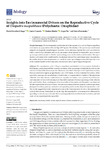Mostrar o rexistro simple do ítem
Insights into Environmental Drivers on the Reproductive Cycle of Diopatra neapolitana (Polychaeta: Onuphidae)
| dc.contributor.author | Escobar Ortega, Daniel | |
| dc.contributor.author | Couceiro, Lucía | |
| dc.contributor.author | Muíño, Ramón | |
| dc.contributor.author | No, Edgar | |
| dc.contributor.author | Fernández, Nuria | |
| dc.date.accessioned | 2023-01-05T13:22:36Z | |
| dc.date.available | 2023-01-05T13:22:36Z | |
| dc.date.issued | 2022-10-14 | |
| dc.identifier.citation | Escobar-Ortega, D.; Couceiro, L.; Muíño, R.; No, E.; Fernández, N. Insights into Environmental Drivers on the Reproductive Cycle of Diopatra neapolitana (Polychaeta: Onuphidae). Biology 2022, 11, 1504. https://doi.org/10.3390/biology11101504 | es_ES |
| dc.identifier.issn | 2079-7737 | |
| dc.identifier.uri | http://hdl.handle.net/2183/32302 | |
| dc.description | Data are available in a publicly accessible repository: https://doi.org/10.5281/zenodo.7081249 (accessed on 14 September 2022). | es_ES |
| dc.description.abstract | [Abstract] The reproductive cycle of Diopatra neapolitana was studied over two years in Redondela (NW Spain), considering both the monthly evolution of the percentage of individuals with oocytes and the variation of the mean oocyte size. Moreover, since three other species of Diopatra have recently been documented in regions geographically close to NW Spain, we first confirmed the identity of this species by carrying out a morphological identification of a representative number of the specimens collected. Our data showed a discontinuous reproductive season, with a period of proliferation and maturation of oocytes from January to September and asynchronous spawning events between July and October. Then, a resting period in the months of November and December was observed. We also explored the influence of some relevant environmental factors (namely, water temperature, photoperiod, salinity, primary production and upwelling index) on the observed reproductive cycle. The results suggest that water temperature is one of the most important drivers of the reproductive cycle for this species. Particularly, in Ría de Vigo, the reproductive cycle seems to be influenced by upwelling events of deep cold water that occur frequently between March and September, and that could act as a spawning-inducing switch. | es_ES |
| dc.description.sponsorship | This study was funded by the Galician Regional Government (Xunta de Galicia), through a collaboration agreement between the Galician Regional Ministry of the Sea (Consellería do Mar) and the University of A Coruña (UDC) for the research action: Basic aspects of the biology of polychaetes exploited in the coasts of Galicia. Criteria for the management of exploited populations (reference: CIMA 18/05). Morphological identification analysis was conducted at the Universidade de Aveiro (Portugal) through the pre-doctoral fellowship programme “Ayudas para estancias predoctorales Inditex-UDC 2021”. SEM work was performed at the EMSO-PT Laboratory of Biodiversity and Connectivity & COBI, Universidade de Aveiro. EMSO-PT is funded by Portugal 2020, in the framework of COMPETE2020 (Programa Operacional Competitividade e Internacionalização-POCI), and FEDER (Fundo Europeu de Desenvolvimento Regional, ref. 01/SAICT/2016) and by national funds (OE), through FCT/MCTES (ref. PINFRA/22157/2016 EMSO-PT). | es_ES |
| dc.description.sponsorship | Portugal. Fundação para a Ciência e a Tecnologia; PINFRA/22157/2016 EMSO-PT | es_ES |
| dc.description.uri | https://doi.org/10.5281/zenodo.7081249 | |
| dc.language.iso | eng | es_ES |
| dc.publisher | MDPI | es_ES |
| dc.relation.uri | https://doi.org/10.3390/biology11101504 | es_ES |
| dc.rights | Atribución 4.0 Internacional | es_ES |
| dc.rights.uri | http://creativecommons.org/licenses/by/4.0/ | * |
| dc.subject | Taxonomy | es_ES |
| dc.subject | Bristle worm | es_ES |
| dc.subject | Reproduction | es_ES |
| dc.subject | Galicia | es_ES |
| dc.subject | Maturation cycle | es_ES |
| dc.title | Insights into Environmental Drivers on the Reproductive Cycle of Diopatra neapolitana (Polychaeta: Onuphidae) | es_ES |
| dc.type | info:eu-repo/semantics/article | es_ES |
| dc.rights.access | info:eu-repo/semantics/openAccess | es_ES |
| UDC.journalTitle | Biology | es_ES |
| UDC.volume | 11 | es_ES |
| UDC.issue | 10 | es_ES |
| UDC.startPage | 1504 | es_ES |
| dc.identifier.doi | 10.3390/biology11101504 |






